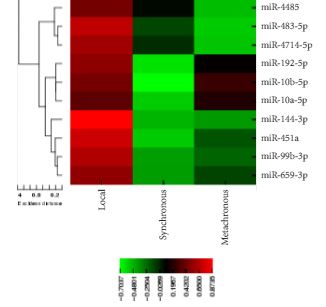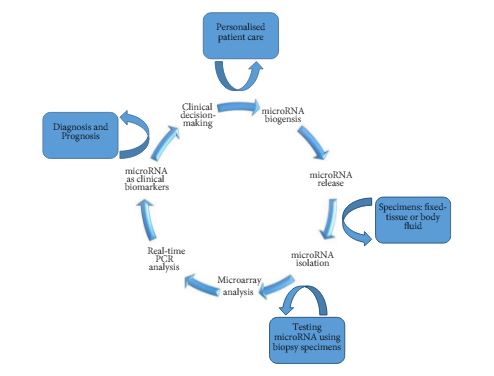A twenty two year old male was referred to our urology outpatient clinic for the evaluation of persistent scrotal discomfort following a culture proven E. Coli urinary tract infection(UTI). His initial UTI had been successfully treated by his General Practitioner with oral ciprofloxacin. The patient had no significant medical or psycho-social history, was sexually inactive and had no family history of note. Other than vague scrotal discomfort that was persistent for six weeks he had no genito-urinary symptoms.
General and abdominal examination were normal. Specifically his height and weight were within the normal range, he had no gynaecomastia, had normally distributed body and pubic hair and had no excessive skin freckling around his head area. Examination of his scrotum revealed small testes bilaterally. The right testicle had a small, palpable and tender nodule in the interpolar region. Examination of the left testicle was normal.
A testicular ultrasound demonstrated multiple hypoechoic lesions within both testes (Fig. 1).
Figure 1. A testicular ultrasound demonstrated multiple hypoechoic lesions within both testes
The largest lesion (palpable) measured 1 x 0.7cm. There was no associated increase in vascularity and both epididymides were normal in appearance with no ultrasonic features of epididymo-orchitis. The radiological findings were reported a consistent with lymphoma or less likely multifocal seminoma.
A follow-up CT scan of his neck, thorax, abdomen and pelvis demonstrated no evidence of para-aortic lymphadenopathy or metastatic disease. Testicular tumour markers were all within the normal range. The case was discussed both pre and post operatively at our institution’s multi-disciplinary team meeting.
The patient underwent right testicular exploration via an inguinal approach. Intra-operative examination of the right testis revealed a small testis with a 10mm interpolar nodule corresponding to clinical and radiological findings. The nodule was locally excised and sent for frozen section evaluation. Grossly, this 10 x 10 x 8mm nodule had a glistening outer surface and when sectioned had a smooth, cream surface. Histological examination showed a benign sertoli cell hamartoma (adenoma) with no evidence of intratubular germ cell neoplasia. Two further ultrasound guided biopsies of the same testis were performed. Repeated frozen section analysis of these separate lesions demonstated atrophic seminiferous tubules with focally prominent Leydig cells, pathologically typical of a cryptorchid testis.
Fig.2. Sertoli cell hamartoma stained with hematoxylin and eosin stain at 20x (A), 100x (B), 200x (C) and 400x (D)and magnification
Both testes were preserved and the patient made an uncomplicated post operative recovery. At a six month review, all genitourinary symtoms had resolved, with no evidence of testicular atrophy or endocrine dysfunction. Serum testosterone was normal. Follow-up clinical and ultrasonic examination findings of both testes at 6 weeks and 6 months remained unchanged. The patient performs regular self examination and attends for annual review.
Discussion
Testicular sertoli tumours, first described by Teilum in 1944, account for 1% of all testicular neoplasms and 17% of non germ cell tumours. The majority of sertoli tumours are benign but 10% to 22% have malignant potential with less than 50 cases worldwide [1,2]. Five histological variants are recognised; classic sertoli tumour, large cell calcifying, sclerosing, heterongenous and not otherwise specified (NOS). While sertoli cell tumours were initially reported to present most commonly in the first decade of life, many of these early descriptions occurred before the recognition of testicular juvenile granulosa tumours in 1979. The dramatic reduction in the reporting of sertoli cell tumours in children since then suggests that many of these early reports may have been incorrectly classified [3]. Sertoli cell tumours may still occur in children, but presentation in the 3rd to 5th decade is more typical. Sertoli cell tumours occur in both testes equally, usually presenting as a gradually enlarging testicular mass or as an incidental finding on ultrasound. While hormonal abnormalities are infrequent, gynaecomastia is sometimes seen (5% in benign / 12% in malignant tumours) [4]. Only 11 cases of bilateral sertoli cell tumours are reported in the literature[5-15]. One case of bilateral, plurifocal sertoli cell tumours has been documented previously, occuring in a single cryptorchid testes of a 14 year old girl with testicular feminisation syndrome [7]. Other anecdotal reported conditions associated with sertoli cell tumours include cryptorchidism, Peutz-Jaeger syndrome, the Carney complex and the aquired immunodeficiency syndrome [16]. Systemic clinical features of these associated conditions or systemic effects from hormonally active sex cord-stromal tumours may be the presenting feature which prompts the patient (or their parents) to seek medical attention. In this case, apart from the testicular abnormalities described, our patient had a normal clinical examination at presentation with no other systemic features to suggest the presence of an associated syndrome.
As with most testicular tumours, the standard treatment of unilateral sex chord scrotal tumours is radical inguinal orchidectomy. It permits a definitive pathologic diagnosis and provides local tumour treatment. However the European Association of Urology clinical guidelines suggest that testis-sparing surgery may be considered as an alternative treatment modality in certain circumstances provided surgical rules and principles are respected [17]. This form of treatment should be considered in; a tumour in a solitary testes with normal pre-operative testosterone levels, synchronous bilateral testicular tumours, metachronous contralateral tumours, tumour volume of less than 2 cm or less than 30% of the testicular volume, and infertile / monorchid patients. Secondary orchidectomy can always be performed if the final pathology reveals a non-stromal (e.g. germ cell) tumour.
Our case showed no pre or intra-operative evidence of malignancy. Therefore we elected to perform testis sparing surgery. The rationale for pursuing this clinical management course included consideration of the patient’s age (22 years) and the detrimental impact (both physical and psychological) of performing bilateral radical orchidectomies on a patient in this age group. By preserving both testicles, we have maximised his future fertility potential and have preserved endocrine, exocrine and sexual functions of the testis.
Due to the rarity of the condition and the lack of follow-up in most reported cases, the EAU guidelines on testicular cancer [17] does not make specific recommendations regarding the appropriate follow-up for patients with sertoli-cell tumours. However these guidelines do suggest that an individualised follow-up plan, tailored to the clinical needs of the patient, be implemented. Our patient has had a six month surveillance scrotal ultrasound which has demonstrated no change in comparison to his initial examination and will continue to be reviewed at our urology outpatient department on an annual basis.
Conclusion
Management of benign but potentially malignant bilateral testicular tumours in a young adult male is challenging. A balance between preserving testicular function and optimizing oncological control has to be considered. Without evidence of malignancy, testicular preserving surgery should be considered. The patient needs to be fully informed regarding the nature of the condition and the management options available. An individualised post intervention surveillance strategy needs to implemented to provide optimal patient care.
References
1. Krege S et al. European consensus conference on diagnosis and treatment of germ cell cancer: a report of the second meeting of the European Germ Cell Cancer Consensus Group (EGCCCG): part II. Eur Urol 2008 Mar; 53 (3):497-513.
2. Souchon R, Schmoll HJ, Krege S, for the German Testicular Cancer Study Group (eds). Qualitätsicherung in der Onkologie. 1st edn. München-Bern-Wien-New York- Zuckschwerdt, 2002. German Cancer Society: Evidence-based guideline for the assessment and treatment of testicular tumours.
3. Young RH, Rosenberg AE, Clement PB. Sertoli cell tumors of the testis, not otherwise specified: a clinicopathologic analysis of 60 cases. Mod Pathol. 1997; 10 (12):1228-32.
4. McGlynn KA, Devesa SS, Sigurdson AJ, Brown LM, Tsao L, Tarone RE. Trends in the incidence of testicular germ cell tumours in the United States. Cancer 2003; 97 (1): 63-70.
5. Brown B, Ram A, Clayton P, Humphrey G. J Pediatr Surg. 2007; 42 (9): 13-5.Conservative management of bilateral Sertoli cell tumors of the testicle in association with the Carney complex: a case report.
6. Baksu A, Kabukcuoglu F, Baksu B, Goker N. Sertoli cell adenoma and serous cyst in a patient with androgen insensitivity syndrome. Eur J Obstet Gynecol Reprod Biol. 2004 10; 114 (1): 104-7.
7. Chatelain D, Ricard J, Ghighi C, Colombat M, Leclercq F, Cordonnier C, Pouzac M, Sevestre H, Gontier MF. Plurifocal testicular hamartomas and testicular feminization syndrome. Ann Pathol. 2000; 20 (6): 605-8.
8. Drevelengas A, Kalaitzoglou I, Destouni E, Skordalaki A, Dimitriadis A. Bilateral Sertoli cell tumor of the testis: MRI and sonographic appearance. Eur Radiol. 1999; 9 (9): 1934.
9. White MD, Loughlin MW, Kallakury BV, Ross JS, Mandell J. Bilateral large cell calcifying Sertoli cell tumor of the testis in a 7-year-old boy. J Urol. 1997 158 (4): 1547-8.
10. Noszian IM, Balon R, Eitelberger FG, Schmid N. Bilateral testicular large-cell calcifying sertoli cell tumor and recurrent cardiac myxoma in a patient with Carney’s complex. Pediatr Radiol. 1995; 25 Suppl. 1: S236-7.
11. Dreyer L, Jacyk WK, du Plessis DJ. Bilateral large-cell calcifying Sertoli cell tumor of the testes with Peutz-Jeghers syndrome: a case report. Pediatr Dermatol. 1994; 11 (4): 335-7.
12. Niewenhuis JC, Wolf MC, Kass EJ. Bilateral asynchronous Sertoli cell tumor in a boy with the Peutz-Jeghers syndrome. J Urol. 1994; 152 (4):1246-8.
13. Schumacher A, Rohde E. A rare case of bilateral Sertoli-Leydig cell tumor. Zentralbl Gynakol. 1991; 113 (23):1323-6.
14. Gutirrez Bos JL, Garijo Ayemsa F, Ladrn Gil C, Sandoval F, Picatoste Pati J. Bilateral Sertoli-Leydig cell tumor with heterologous elements: report of an unusual case and review of the literature. Arch Esp Urol.1987; 40 (7): 523-5.
15. Fligiel Z, Kaneko M, Leiter E. Bilateral Sertoli cell tumor of testes with feminizing and masculinizing activity occurring in a child. Cancer. 1976; 38 (4): 1853-8.
16. Robert O. Petersen, Isabell A. Sesterhenn, Charles J. Davis. Urologic Pathology. Vol 3, 2009, page 366
17. P. Albers , W. Albrecht, F. Algaba, C. Bokemeyer, G. Cohn-Cedermark, K. Fizazi, A. Horwich, M.P. Laguna. Guidelines on testicular cancer. European Association of Urology (EAU) clinical guidelines 2010.
Date added to bjui.org: 16/08/2011
DOI: 10.1002/BJUIw-2011-047-web





